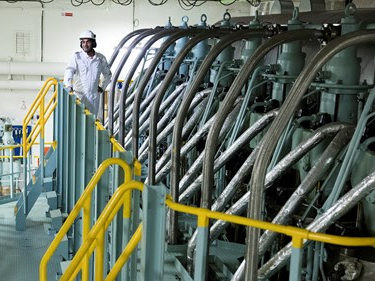PRESS RELEASE: Signing a supply agreement with Hitachi High-Tech Analytical Science (Hitachi High-Tech), Wilhelmsen will supply Hitachi High-Tech’s industry-leading handheld XRF analysers to the maritime market, enabling vessel crews to accurately and efficiently test the sulphur content of their fuel, on the spot.
With the International Maritime Organisation’s 0.50% global sulphur cap on marine fuels set to come into force on 1 January 2020 and discussions on enforcement strategies and potential penalties for non-compliance gathering pace, the ability to perform lab-quality testing in seconds, will soon become an operational necessity for crews, and authorities, alike.
Hitachi High-Tech’s XRF spectrometers are seen as the petroleum industry’s established benchmark for upstream and downstream quality control, requiring little sample prep, minimal training and providing almost instantaneous, verifiable results.
 Jonas Östlund, Product Marketing Manager, Oil and Water, Marine Products Wilhelmsen Ships Service says, “Partnering with Hitachi High-Tech Analytical Science, one of the leading fuel testing specialist, enables us to provide our customers, what we believe will, become an absolutely essential tool ahead of IMO 2020. Crews will be able to eliminate the risk of accidental non-compliance. As vessels approach Emission Control Areas (ECAs), with a lower 0.1%, permissible sulphur content limit, the engine room can immediately and accurately test the Sulphur content of the fuel flowing to the engines after changeover and ensure it is compliant”
Jonas Östlund, Product Marketing Manager, Oil and Water, Marine Products Wilhelmsen Ships Service says, “Partnering with Hitachi High-Tech Analytical Science, one of the leading fuel testing specialist, enables us to provide our customers, what we believe will, become an absolutely essential tool ahead of IMO 2020. Crews will be able to eliminate the risk of accidental non-compliance. As vessels approach Emission Control Areas (ECAs), with a lower 0.1%, permissible sulphur content limit, the engine room can immediately and accurately test the Sulphur content of the fuel flowing to the engines after changeover and ensure it is compliant”
In addition to mitigating the risks of non-compliance during changeovers, fast, reliable, on-board testing equipment lessens the reliance on the traditional Bunker Delivery Note, empowering crews to check the sulphur content of fuel during bunkering, rather than potentially having to deal with potential fuel specification issues after the fact.
Östlund adds, “No hassle testing, onboard and on demand, Hitachi High-Tech’s XRF analysers, along with their industry leading expertise and technical support, will make navigating the new fuel sulphur regulations, while not quite plain sailing, far less of a burden”.
Vito Angona, Global Sales Director, Hitachi High-Tech Analytical Science says, “Our partnership with Wilhelmsen offers customers the best of both worlds, our 45-years of expertise in fuels analysis and Wilhelmsen’s wealth of experience in the shipping services market. We offer a turnkey solution to the market, everything you need for sulphur analysis in one place by one supplier.”

Wilhelmsen will be offering the X-MET8000 handheld XRF analyser from Hitachi High-Tech which complies with ASTM D4294, ISO8754, and IP336 sulphur test methods. Built to be robust enough to be used in a scrapyard, it comes with an embedded GPS to pinpoint exactly where analysis is performed. The X-MET8000 is fast and simple to use making it a frontrunner for owners and operators looking to stay the right side of regulations. Hitachi High-Tech’s cloud service and data-sharing enable you to store, share and manage analysis data anywhere, anytime. Customers will also benefit from in-house service and remote diagnostic services for support. It could also a particularly good fit for Port State Control (PSC) authorities.
With no clear guidance for member states from the IMO as yet, recommended test methods for fuel compliance, various options are under consideration by PSCs, including drone technology to assess smoke plumes and sniffer units in port to detect sulphur emissions.
However, with cost and weather issues affecting such solutions, it is likely mobile equipment, such as the X-MET8000, which PSC officers can use to quickly pass or fail vessels’ fuel, will become the favoured means of testing compliance to the new regulations.
































